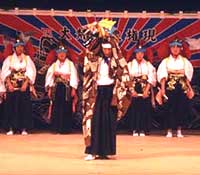
| Pseudonym reading | Prefecture designation |
|---|---|
| Specified type | Intangible folk cultural property |
| Type | |
| Designated date | May 7, 1999 |
| Specified details | |
| quantity | |
| location | Kuji City Natuimachi Character Toriya |
| owner | |
| Holding group | Daisuke Natsui Tenchu Music Preservation Society |
| Management organization | |
| home page |
Overview
Natsumi Daisuke Tenjaku is a Yamabushi Kagura handed down in the coastal area of Iwate Prefecture, and although the influence of both Kuromori Kagura and Kuchinoc Kagura can be recognized, it is difficult to be serialized in any of them, and it has become independent from the present It can be thought of as a lineage.
According to the tradition of the Harima family, who have inherited Kagura, the ancestors are Yamabushi Shukuni from Harima Country (Hyogo Prefecture), carrying the Daisho Tenno Imbo Akira from Japan, coming to Natui to build the Daiho-in, and offering Kasumi ritual to worship the Kongen It is believed that Kagura has been passed down by the area's believers, but it is not clear that it was clear.
Until 1955 he had been performing Kasumi-inspired Kagura.
After that, I was interrupted, but in 1982 the Natsumi Daisuke Tenkagura Preservation Association was formed, and now participate in various events such as the annual festival of Oyama Inari Shrine in Kuji city, the annual festival of Omiya Shrine, and the annual festival of Wakamiya Hachimangu In addition to this, since 1994 he has been trying to train his successors by giving instructions to senior high school and junior high school students.
Natsumi Daisuke Tenkagura had once exceeded 50 performances, but now it is possible to perform 20 performances.
In addition, ceremonial elements such as spring prayers and burn-off prayers by Gongen, which is one of the features of Yamabushi Kagura, are carefully inherited.
Furthermore, in other Yamabushi Kagura, traces of unique interpretation and ingenuity such as “Toshio Mai” with few traditions and respecting dance according to the deities of shrines are seen, and it is important as a distinctive kagura in the northern coast of Iwate Prefecture. It is.
(The fourth intangible folk cultural property designation standard 2 (3) correspondence)
